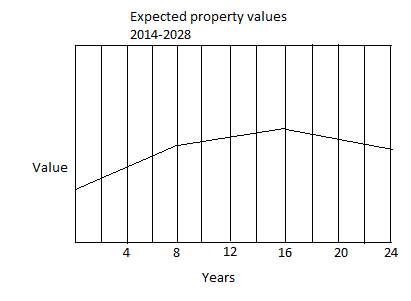
A realtor is studying the figure above, which shows the expected value of properties in her area over the next \[24\] years .If it represents the number of years after \[2014\], in what year should the increase in property value start to slow down?

(A) \[2008\]
(B) \[2018\]
(C) \[2022\]
(D) \[2030\]

Answer
555.6k+ views
Hint: In this question, the property values are given for specific years in graphical representation and the starting year also given.
We have to find out the year where the increase in property value starts to slow down.
We need to first observe the graph and find out the year where the increase in property value starts to slow down then we need to add that year with the starting year.
Complete step by step solution:
The given observations are the graphical representation of the expected property values from year \[2014 - 2028\].
We need to find out the year where the increase in property value starts to slow down.
We can see in the graph that the expected property values are going up till the year \[16\] after that it is going down.
The graph starts from the year \[2014\].
Thus the increase in property value start to slow down in \[2014 + 16 = 2030\]
$\therefore $ Option (D) is the correct option.
Note: Graphical representation:
Graphical representation refers to the use of charts and graphs to visually display, analyse, clarify, and interpret numerical data, functions, and other qualitative structures. Data is ingested into graphical representation of data software and then represented by a variety of symbols, such as lines on a line chart, bars on a bar chart, or slices on a pie chart, from which users can gain greater insight than by numerical analysis alone.
We have to find out the year where the increase in property value starts to slow down.
We need to first observe the graph and find out the year where the increase in property value starts to slow down then we need to add that year with the starting year.
Complete step by step solution:
The given observations are the graphical representation of the expected property values from year \[2014 - 2028\].
We need to find out the year where the increase in property value starts to slow down.
We can see in the graph that the expected property values are going up till the year \[16\] after that it is going down.
The graph starts from the year \[2014\].
Thus the increase in property value start to slow down in \[2014 + 16 = 2030\]
$\therefore $ Option (D) is the correct option.
Note: Graphical representation:
Graphical representation refers to the use of charts and graphs to visually display, analyse, clarify, and interpret numerical data, functions, and other qualitative structures. Data is ingested into graphical representation of data software and then represented by a variety of symbols, such as lines on a line chart, bars on a bar chart, or slices on a pie chart, from which users can gain greater insight than by numerical analysis alone.
Recently Updated Pages
Why are manures considered better than fertilizers class 11 biology CBSE

Find the coordinates of the midpoint of the line segment class 11 maths CBSE

Distinguish between static friction limiting friction class 11 physics CBSE

The Chairman of the constituent Assembly was A Jawaharlal class 11 social science CBSE

The first National Commission on Labour NCL submitted class 11 social science CBSE

Number of all subshell of n + l 7 is A 4 B 5 C 6 D class 11 chemistry CBSE

Trending doubts
What is meant by exothermic and endothermic reactions class 11 chemistry CBSE

1 Quintal is equal to a 110 kg b 10 kg c 100kg d 1000 class 11 physics CBSE

What are Quantum numbers Explain the quantum number class 11 chemistry CBSE

What is periodicity class 11 chemistry CBSE

What is a periderm How does periderm formation take class 11 biology CBSE

Mention the basic forces in nature class 11 physics CBSE




